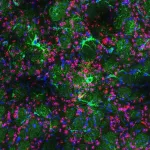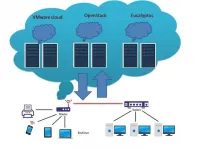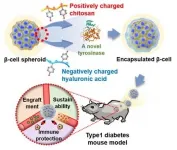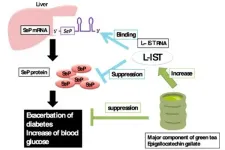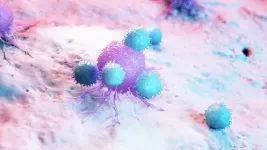Novel risk score for predicting blood cancer relapse
Medical researchers in China develop a new risk score to predict relapse of leukemia
2021-06-24
(Press-News.org) Leukemia is a group of blood cancers that affects thousands of people worldwide. However, with advances in medicine, several different types of leukemia can be effectively treated with donor stem cells through allogenic stem cell transplantation (allo-SCT). One such type of leukemia is B-cell acute lymphoblastic leukemia (B-ALL), which is caused by uncontrolled proliferation and prolonged existence of cancerous B-cells. While allo-SCT can 'cure' B-ALL in several cases, there are also cases of failure, characterized by deterioration in health after a period of recovery--a phase medically known as relapse. Early prediction of this unfavorable outcome can have several medical advantages for the corresponding patients and the healthcare system.
To address this challenge, a group of medical researchers from Beijing Key Laboratory of Hematopoietic Stem Cell Transplantation, Peking University, and Chinese Academy of Medical Sciences successfully developed an effective risk score that can accurately predict leukemia relapse, after allo-SCT. Their findings have been published as a research article in Chinese Medical Journal.
Detailing the comprehensive methodology used in the study, Dr. Xiao-Jun Huang from Peking University Institute of Hematology, Peking University People's Hospital, who led the study, explains, "We enrolled 477 patients with B-ALL who underwent allo-SCT at Peking University People's Hospital from December 2010 to December 2015 in this retrospective study. We aimed to evaluate the factors associated with transplant outcomes after allo-SCT and establish a risk score to identify patients with different probabilities of relapse. We performed univariate and multivariate analyses with the Cox proportional hazards model using time-dependent variables to analyze our data."
As mentioned by Dr. Huang, some of the analyzed factors associated with allo-SCT transplant outcomes included engraftment of white blood cell like neutrophils, and platelets, in the patients; presence of residual cancer cells, measured as minimal residual disease (MRD); occurrence of chronic graft-versus-host disease (cGVHD); and decrease in leukemia symptoms, medically known as remission, after the procedure. Then, the researchers went on to identify if these factors could be used to determine outcomes like 5-year cumulative incidence of relapse (CIR), overall survival (OS), leukemia-free survival (LFS), and non-relapse mortality, in the patients. Finally, these results were used to formulate the risk score.
In the patients assessed for the different factors previously described, the researchers notably observed that all of them achieved neutrophil engraftment, and 95.4% of them achieved platelet engraftment. Also, they observed that 20.7% of the patients showed CIR, 70.4% of them survived overall, 65.6% endured LFS, and 13.9% succumbed to non-relapse mortality.
Further statistical analysis allowed the researchers to observe distinct associations between the analyzed factors and evaluated outcomes. In this regard, Dr. Huang, excitedly explains, "Our analysis showed that patients with positive post-transplantation MRD, transplanted beyond the first complete remission (?CR2), and without cGVHD, had higher CIR and worse LFS, and OS , than did patients without MRD after transplantation, transplanted in CR1, and with cGVHD." With such apparent observations, as explained by Dr. Huang, the researchers immediately went on to devising their risk score.
The novel risk score pinned 5-year relapse rates of 6.3%, 16.6%, 55.9%, and 81.8%, as 0, 1, 2, and 3, respectively. The researchers also added that, with increasing risk score, the 5-year LFS and OS values correspondingly decreased.
Overall, the researchers hope that the risk score that they have devised will serve as a guide for leukemia treatment, by allowing stratification of patients with different risks of relapse. They also hope that this will allow for better medical intervention. Indeed, the world can hope that this risk score serves a milestone in leukemia relapse prediction.
INFORMATION:
Reference
Title of original paper: A risk score system for stratifying the risk of relapse in B cell acute lymphocytic leukemia patients after allogenic stem cell transplantation
Journal: Chinese Medical Journal
DOI: https://doi.org/10.1097/CM9.0000000000001402
[Attachments] See images for this press release:

ELSE PRESS RELEASES FROM THIS DATE:
2021-06-24
The brain is not a passive recipient of injury or disease. Research has shown that when neurons die and disrupt the natural flow of information they maintain with other neurons, the brain compensates by redirecting communications through other neuronal networks. This adjustment or rewiring continues until the damage goes beyond compensation.
This process of adjustment, a result of the brain's plasticity, or its ability to change or reorganize neural networks, occurs in neurodegenerative conditions such as Alzheimer's, Parkinson's and Huntington's disease (HD). As the conditions progress, many genes change the way they are normally expressed, turning some genes up and others down. The challenge for researchers like Dr. Juan Botas ...
2021-06-24
The central goal of cloud computing is to provide fast, easy-to-use computing and data storage services at a low cost. However, the cloud environment comes with data confidentiality risks attached.
Cryptography is the primary tool used to enhance the security of cloud computing. This mathematical technique protects the stored or transmitted data by encrypting it, so that it can only be understood by intended recipients. While there are many different encryption techniques, none are completely secure, and the search continues for new technologies that can counter the rising threats to data privacy and security.
In a recent study published in KeAi's International Journal of Intelligent Networks, a team of researchers from India and Yemen describe a novel, two-step cryptography ...
2021-06-24
A research team, led by Prof. Nathaniel S. Hwang and Prof. Byung-gee Kim, from Seoul National University (SNU) and Prof. Dong Yun Lee, from Hanyang University, has used enzymatic crosslinking to create nanofilms on cell surfaces. SNU has announced that it has developed a "cell caging" technology for the applications in cell-based therapies. The "cell caging" technique can prevent immune rejection during heterologous islet cell transplantation, facilitate smooth cell insulin secretion, and treat type 1 diabetic patients without immunosuppressants.
The research team succeeded in producing a nanofilm by using the electrostatic force to stack chitosan, which is a biological polymer, and hyaluronic acid in that order. To overcome the shortcomings ...
2021-06-24
Across the world, type 2 diabetes is on the rise. A research group has discovered a new gene that may hold the key to preventing and treating lifestyle related diseases such as type 2 diabetes.
The results of their research were published in the journal Nucleic Acids Research on June 18, 2021.
Selenoprotein P (SeP) is an essential plasma protein containing the micronutrient selenium. However, too much SeP spells trouble.
Excess SeP increases insulin resistance, thus weakening the effect of insulin, and worsening the metabolism of glucose.
"Excess SeP is the enemy when it comes to type 2 diabetes," stressed professor Yoshiro Saito from the Graduate School of Pharmaceutical Sciences at Tohoku University and co-author of the ...
2021-06-24
Female elephant seal weigh on average 350 kg, and dive continuously to the ocean's mesopelagic zone, about 200 to 1,000 meters deep, to consume their only prey: small fish that weigh less than 10 grams. Now, an international team of researchers, armed with eight years of data, may have answered a decades-long question: How do seals maintain their large size on such small prey?
They published their answer on May 12 in Science Advances.
"It is not easy to get fat," said paper author Taiki Adachi, research fellow with the National Institute of Polar Research and the School of Biology, University of St Andrews. "Elephant seals have to spend almost ...
2021-06-24
Genome study reveals East Asian coronavirus epidemic 20,000 years ago
An international study has discovered a coronavirus epidemic broke out in the East Asia region more than 20,000 years ago, with traces of the outbreak evident in the genetic makeup of people from that area.
Professor Kirill Alexandrov from CSIRO-QUT Synthetic Biology Alliance and QUT's Centre for Genomics and Personalised Health, is part of a team of researchers from the University of Arizona, the University of California San Francisco, and the University of Adelaide who have published their findings in the journal Current Biology.
In the past 20 years, there have been three outbreaks of epidemic severe coronaviruses: ...
2021-06-24
In the 1950s, researchers made the first unexpected discoveries of dinosaur remains at frigid polar latitudes. Now, researchers reporting in the journal Current Biology on June 24 have uncovered the first convincing evidence that several species of dinosaur not only lived in what's now Northern Alaska, but they also nested there.
"These represent the northernmost dinosaurs known to have existed," says Patrick Druckenmiller of the University of Alaska Museum of the North. "We didn't just demonstrate the presence of perinatal remains--in the egg or just hatched--of one or two species, rather we documented at ...
2021-06-24
Images of dinosaurs as cold-blooded creatures needing tropical temperatures could be a relic of the past.
University of Alaska Fairbanks and Florida State University scientists have found that nearly all types of Arctic dinosaurs, from small bird-like animals to giant tyrannosaurs, reproduced in the region and likely remained there year-round.
Their findings are detailed in a new paper published in the journal Current Biology.
"It wasn't long ago that people were pretty shocked to find out that dinosaurs lived up in the Arctic 70 million years ago," said Pat Druckenmiller, the paper's lead author and director of the ...
2021-06-24
The 'anterior cingulate cortex' is key brain region involved in linking behaviours to their outcomes.
When this region was temporarily silenced, monkeys did not change behaviour even when it stopped having the expected outcome.
The finding is a step towards targeted treatment of human disorders involving compulsive behaviour, such as OCD and eating disorders, thought to involve impaired function in this brain region.
Researchers have discovered a specific brain region underlying 'goal-directed behaviour' - that is, when we consciously do something with a particular goal in mind, for example going to the shops to buy food.
The ...
2021-06-24
LA JOLLA, CA--New research led by scientists at La Jolla Institute for Immunology (LJI) and the University of Liverpool may explain why many cancer patients do not respond to anti-PD-1 cancer immunotherapies--also called checkpoint inhibitors.
The team reports that these patients may have tumors with high numbers of T follicular regulatory (Tfr) cells.
In a healthy person, Tfr cells do the important job of stopping haywire T cells and autoantibodies from attacking the body's own tissues. But in a cancer patient, Tfr cells dramatically dial back the body's ability to kill cancer cells.
Anti-PD-1 cancer immunotherapies boost the body's cancer-fighting T cells, but ...
LAST 30 PRESS RELEASES:
[Press-News.org] Novel risk score for predicting blood cancer relapse
Medical researchers in China develop a new risk score to predict relapse of leukemia

